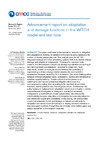This paper contributes to the normative literature on mitigation and adaptation by framing the question of the optimal policy balance in the context of climate catastrophic risk. The analysis uses the WITCH integrated assessment model presenting updates both in its climate change damage and adaptation components. Compared to previous model versions, the first includes a brand new damage specification accounting for the role of autonomous adaptation, ecosystems losses and, most importantly, models an endogenous link between the probability of experiencing a climate-change related catastrophic event and the temperature increase caused by GHG emissions. The second distinguishes between different adaptation types: anticipatory, reactive and investment in adaptive capacity building. Results indicate that the presence of catastrophic risk induces substantial mitigation effort even in a non-cooperative setting, that, according to the standard deterministic literature, usually presents very low mitigation efforts. Furthermore, the policy balance is realigned from adaptation toward more mitigation, and the responsiveness of mitigation to changes in adaptation decreases. Compared to a world without climate catastrophes, risk reduces the substitutability between adaptation and mitigation because only mitigation can reduce the catastrophic probability. In this setting, our analysis also shows that adaptation funds and strategic unilateral commitments to adaptation are not the most efficient ways of buying emission reduction in less developed countries, though they could create some welfare gains and induce abatement in the recipient countries.
- jel: C61, D58, Q5
CMCC Divisions
Authors
- Keywords: Climate change, mitigation, adaptation, climate risk, integrated assessment


